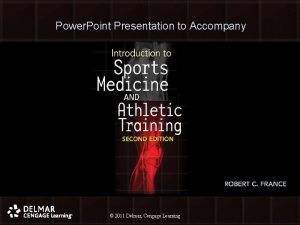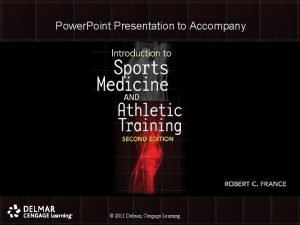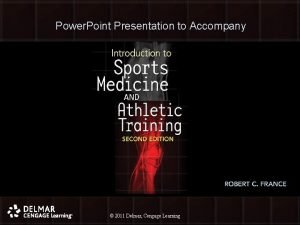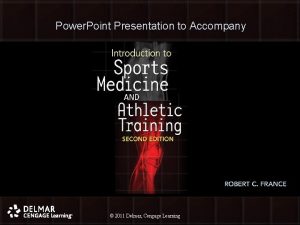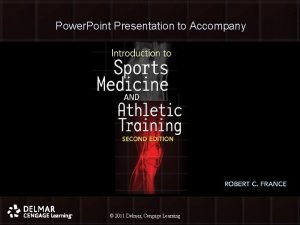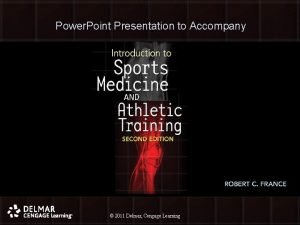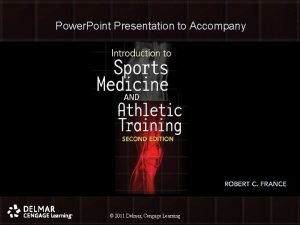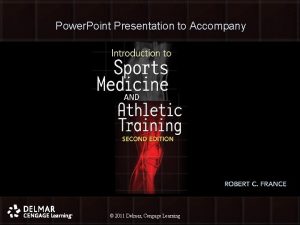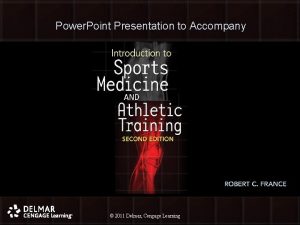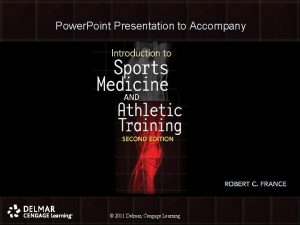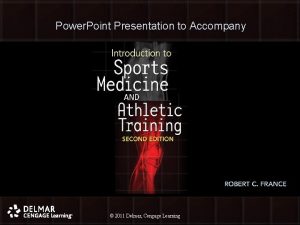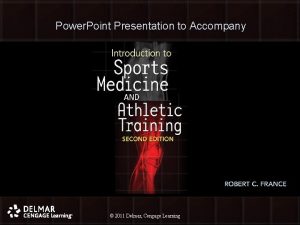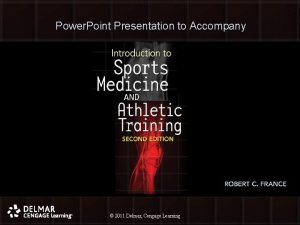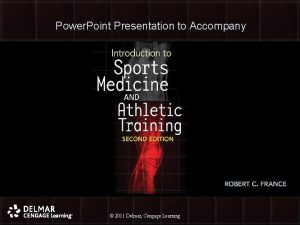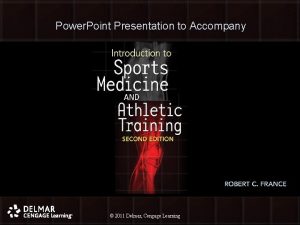Power Point Presentation to Accompany 2011 Delmar Cengage
















- Slides: 16

Power. Point Presentation to Accompany © 2011 Delmar, Cengage Learning © 2010 Delmar, Cengage Learning

Chapter 5 Emergency Preparedness: Injury Game Plan © 2011 Delmar, Cengage Learning © 2010 Delmar, Cengage Learning 2

Objectives • Upon completion of this chapter, you should be able to: – Define emergency preparedness – Discuss the importance of a written action plan for emergencies – List the components of the emergency plan – State the roles of everyone involved in an athletic emergency – Activate the EMS system © 2011 Delmar, Cengage Learning © 2010 Delmar, Cengage Learning 33

Objectives (cont’d. ) • Upon completion of this chapter, you should be able to (cont’d. ): – Identify the difference between defined medical emergencies and nonemergencies – Explain why athletic emergency cards are important © 2011 Delmar, Cengage Learning © 2010 Delmar, Cengage Learning 44

Emergency Preparedness • Be properly equipped and trained for any medical crisis or disaster – Athletic injuries can occur at any time • Sports medicine team must be prepared – Emergency plans help ensure the best care is provided • Athletic organizations must develop an emergency plan © 2011 Delmar, Cengage Learning © 2010 Delmar, Cengage Learning 55

Emergency Action Plan (EAP) • Should be customized to fit needs – Should specify needs within four categories: • • Emergency personnel Emergency communication Emergency equipment Transportation © 2011 Delmar, Cengage Learning © 2010 Delmar, Cengage Learning 66

Emergency Action Plan (cont’d. ) • Should outline emergency personnel roles – Generally the first responder is a member of the athletic training staff • Athletic training staff is, at a minimum, trained in CPR and first aid • All members are responsible for knowing and being able to implement the emergency action plan © 2011 Delmar, Cengage Learning © 2010 Delmar, Cengage Learning 77

Emergency Action Plan (cont’d. ) • Each member should be assigned specific roles – Immediate care should be done by the most qualified – Others should be assigned to locate and obtain emergency equipment – One member should be assigned to activate the emergency medical service (EMS) system © 2011 Delmar, Cengage Learning © 2010 Delmar, Cengage Learning 88

Emergency Action Plan (cont’d. ) • Emergency communication – Good working relationships ensure the best care – Staff must have access to a telephone or telecommunications device • A backup plan should be in place in case the primary communications system is inoperable • Procedure should be in place for communicating the situation to EMS providers © 2011 Delmar, Cengage Learning © 2010 Delmar, Cengage Learning 99

Emergency Action Plan (cont’d. ) • All equipment that might be necessary for an emergency must be: – Readily accessible – In good working condition – Checked before each event or competition © 2011 Delmar, Cengage Learning © 2010 Delmar, Cengage Learning 1010

Emergency Action Plan (cont’d. ) • EMS providers and an ambulance should be on standby at any event where there is a high risk of traumatic injury – Lessens response time for EMS – Ensures injured athlete receives timely, proper care © 2011 Delmar, Cengage Learning © 2010 Delmar, Cengage Learning 1111

Identifying a Medical Emergency • Defined medical emergencies consist of: – Breathing cessation, severe bleeding, no pulse, concussion with loss of consciousness, neck or spinal injury, fractures, dislocations, eye injuries, severe asthma attack, heatrelated illness, or any injury causing signs of shock © 2011 Delmar, Cengage Learning © 2010 Delmar, Cengage Learning 1212

Identifying a Medical Emergency (cont’d. ) • Nonemergencies consist of all other injuries where life or limb is not threatened – Abrasions, minor cuts, strains, sprains, minor concussions without loss of consciousness, and contusions © 2011 Delmar, Cengage Learning © 2010 Delmar, Cengage Learning 1313

Emergency Medical Cards • Each athlete must have an up-to-date emergency information profile on record – Nearest relative or guardian – Medical information – Hospital preference – Family doctor’s phone numbers – Parental permission to treat and transport © 2011 Delmar, Cengage Learning © 2010 Delmar, Cengage Learning 1414

Conclusion • Emergency preparedness is the central element of a superior sports medicine program • The emergency preparedness team consists of everyone involved in athletics • The emergency plan must be documented and agreed upon by all parties • Being properly prepared is crucial © 2011 Delmar, Cengage Learning © 2010 Delmar, Cengage Learning 1515

Conclusion (cont’d. ) • Encourage ownership of the emergency plan • Understand the difference between defined medical emergencies and nonemergencies • Emergency medical cards should be on the sideline of every practice and game © 2011 Delmar, Cengage Learning © 2010 Delmar, Cengage Learning 1616
 2009 delmar cengage learning
2009 delmar cengage learning 2009 delmar cengage learning
2009 delmar cengage learning Chapter 1 learning exercises medical terminology
Chapter 1 learning exercises medical terminology 2009 delmar cengage learning
2009 delmar cengage learning 2009 delmar cengage learning
2009 delmar cengage learning 2009 delmar cengage learning
2009 delmar cengage learning Chapter 10 cultural diversity
Chapter 10 cultural diversity Delmar cengage learning instructor resources
Delmar cengage learning instructor resources Hebrews 6:9-12 sermon
Hebrews 6:9-12 sermon Accompany chapter 1
Accompany chapter 1 Upper limb venous anatomy
Upper limb venous anatomy Printers create objects such as prototypes and models.
Printers create objects such as prototypes and models. Hindi presentation topics
Hindi presentation topics Power point presentation design west vancouver
Power point presentation design west vancouver Delmar isotonic
Delmar isotonic Delmar tsi
Delmar tsi Delmar international (thailand)
Delmar international (thailand)














